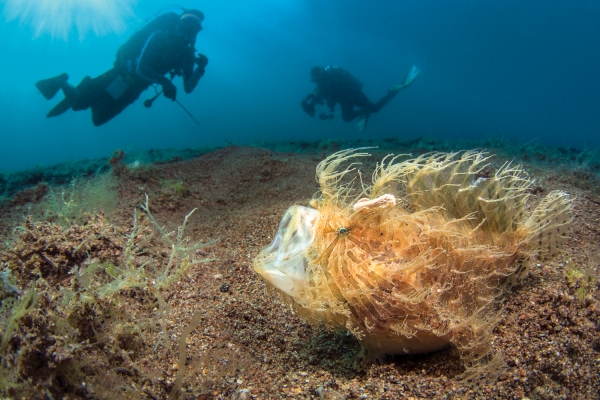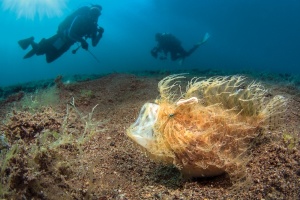Muck Diving

What the Muck is Muck Diving?
Have you ever heard of muck diving? I never had. Although when you think about it, it is pretty much what it sounds like – looking for odd and fabulous creatures in the muck at the bottom of the ocean. Muck diving has been growing in popularity among underwater photographers over the last couple of decades. Many come away with a pot load of pictures but those that are more disciplined will choose to come away with a handful of really memorable images.
The image below is a yawning hairy frogfish shot by Alex Mustard while muck diving in Dumaguete, Negros, Philippines.
The following excerpt is from an article by Alex Mustard in SportDiver.com. It will provide you with some photo tips on your next muck diving adventure.
…It’s not the scenery that draws us, but the super abundance of subjects. Everywhere the guide points his stick there are weird and wonderful creatures, most of which stay stock-still posing, displaying their outrageous adaptations for survival. I’ve seen photographers come out of the water laughing; it’s the only emotion that computes when faced with such an embarrassment of photographic riches.
Don’t Muck It Up
Creating stunning images on muck dives starts with proper muck-diving skills. A careless diver will stir up soft sediments, filling everyone’s photos with backscatter. Face down, fins up is the way to dive on muck. This keeps your nose close to the ground for spotting and your fins clear of the sand. Many muck divers use a metal pointer, or “muck stick,” to enable them to settle on the sand, hold position and take off with minimum disturbance. Pay attention to the direction of the current and approach upstream.
Experienced muck divers tend to stick to their guides like glue, as the easiest place to find a mimic octopus, hairy frogfish or ornate ghost pipefish is right at the end of your guide’s pointer. Dive well and do what you are told. Remember, the less a guide has to look after you, the more time he will have to spot and show you critters. It is also important to share subjects evenly, so make sure other photographers and nonphotographers get an equal look.
Avoid the Ugly Muck
Black sand is rarely pure obsidian; instead it is flecked with grains, shells and pebbles of every color. In short, it’s a messy, distracting background, so the photographic challenge becomes hiding the muck.
The simplest method is to search for a critter sitting up, away from the seabed, or crawling over a rock, like the nudibranch allowing itself to be framed against a clean background. The lower you’re able to get the camera, the better the background becomes.
Most of the muck stars, however, live on the sand and rarely pose for the camera, so you must get creative to control your backgrounds. Consider opening up the aperture to throw the background further out of focus; you can also de-emphasize the distracting sand with your lighting. A final strategy is to use a wide-angle lens very close to the subject, which will make individual distractions in the background insignificant.
Get Closer
Muck dives often have low visibility and suit very close-focus techniques. …I also shoot muck dives with close-focusing wide-angle lenses, although only when there are larger subjects like frogfish around, which I know will allow me to get super close.
To read the entire article click here.











